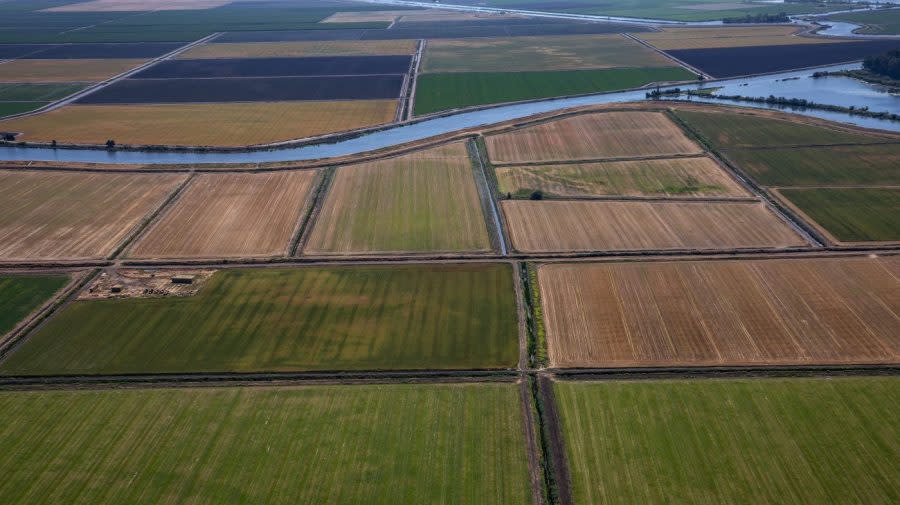Report calls for revamp of federal farming subsidies in drought-ridden Colorado River basin

Federally funded drought adaptation incentives may be failing to equip Colorado River farmers with the tools necessary to adapt to changing climate conditions, a new report has found.
The U.S. Department of Agriculture’s (USDA) Crop Insurance Program paid farmers in Arizona, California, Colorado, Nevada, New Mexico, Utah and Wyoming $5.6 billion for drought-related losses from 2017 to 2023, per the report, released this week by the Environmental Working Group, a nongovernmental organization.
At the same time, the agency provided $521.7 million in subsidies to area farmers through the Environmental Quality Incentives Program (EQIP) for the installation of more efficient irrigation technologies, the document noted.
Yet in a region where three-quarters of water withdrawn from the Colorado River is used to irrigate crops, the report argued that these programs are not living up to their potential.
“The Colorado River region is only going to get hotter and drier, so the government must incentivize growers to make better decisions about what they plant and where,” author Anne Schechinger, Midwest director and agricultural economist for the Environmental Working Group, said in a statement.
While alfalfa and other forms of hay are responsible for 46 percent of all Colorado River water consumption, farmers of these and other livestock feed crops receive the most drought-related crop insurance payments — at more than $2 billion, per the report.
To provide a clear breakdown of drought-related compensation, Schechinger combined payments for drought, heat, water supply failures and irrigation glitches, as well as for “rainfall index” policies — those that pay out if a farmer’s area receives less-than-average rainfall during the growing season.
Farmers in California collected the most drought-related payments, at $2.1 billion, while those in Colorado received the second highest amount, at more than $1 billion, the report observed.
As far as the EQIP irrigation program is concerned, Schechinger found that implementing more efficient irrigation technologies didn’t necessarily lead to a reduction in overall water use.
She attributed this phenomenon due to the unique concept of Western water rights in which a priority-based consumption system requires farmers to “use it or lose it” in years to come.
If a water rights holder in the U.S. West fails to put that right to “beneficial use” for a prescribed number of years, then that individual can be forced to abandon the allotment entirely.
Such long-ingrained policies, Schechinger argued, end up encouraging farmers to use their entire water allocation to irrigate their crops — even when their crops don’t require that full supply.
Schechinger maintained that conservation dollars spent on updating irrigation systems aren’t actually helping farmers to adapt and become more resilient to the impacts of climate change.
Expressing concern that farmers in the Colorado River states “are on a collision course with the climate crisis,” the report emphasized the need to rethink the types of crops cultivated in the region. USDA farm programs could be instrumental in catalyzing this shift, according to the author.
“The USDA’s conservation and crop insurance programs must be reformed to help farmers adapt to drought and reduce funding for farming practices that undermine the region’s climate resilience,” Schechinger said.
“But with or without these changes, in the near future, farmers in the West will not be able to farm what and how they farm today,” she added.
In response to the report, a USDA spokesperson told The Hill in an email that the federal Crop Insurance Program “provides producers the ability to deal with changing climate and extreme weather events that otherwise might put family farms out of business.”
Stressing that Congress sets subsidy rates and other such parameters, the spokesperson said that the agency “does not have the regulatory authority to restrict where and what producers plant.”
The response described EQIP as “just one tool in an array of financial resources” that the USDA has instituted to help communities cope with climate change and water scarcity.
The agency’s comprehensive approach, the spokesperson added, aims to “assist impacted producers with conserving water, promoting irrigation and water-use efficiency, and recovering from economic damages incurred from drought.”
Copyright 2024 Nexstar Media, Inc. All rights reserved. This material may not be published, broadcast, rewritten, or redistributed.
For the latest news, weather, sports, and streaming video, head to The Hill.


